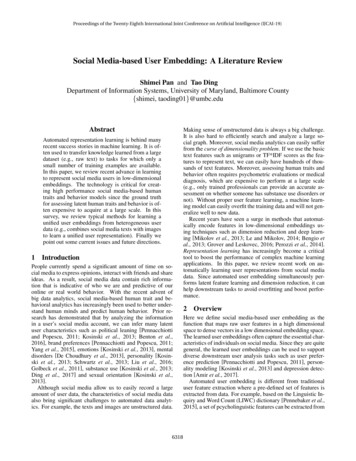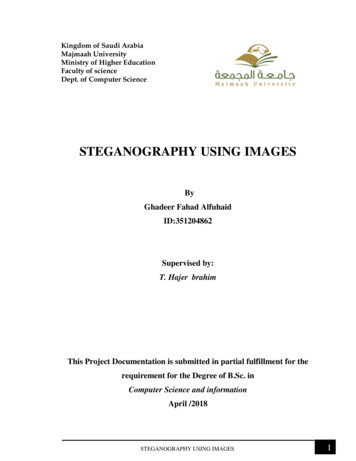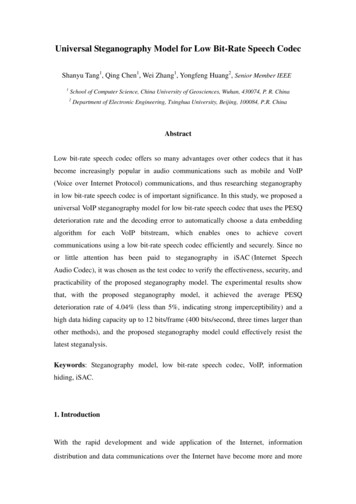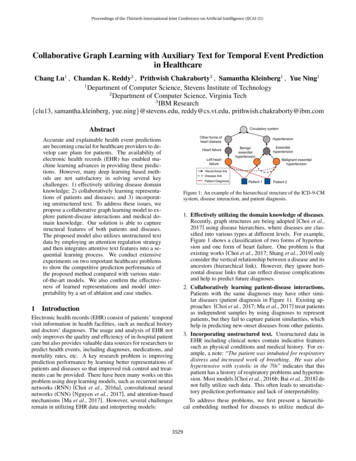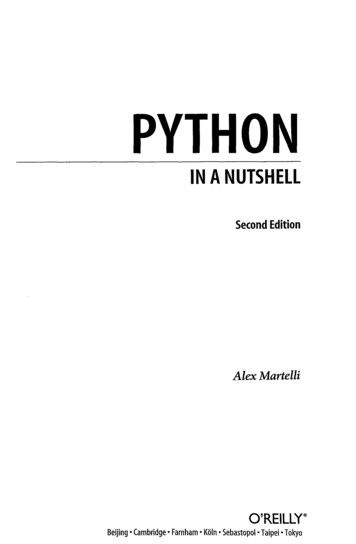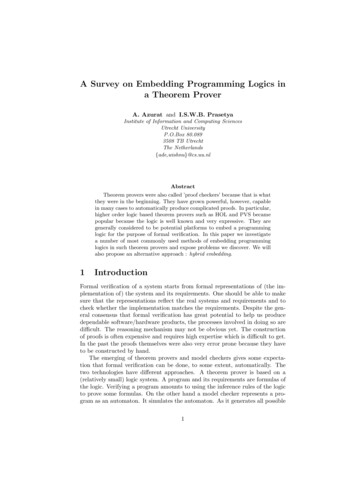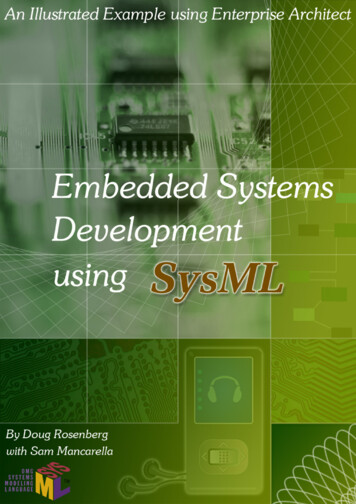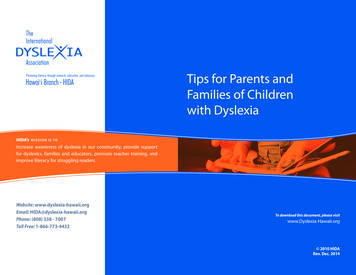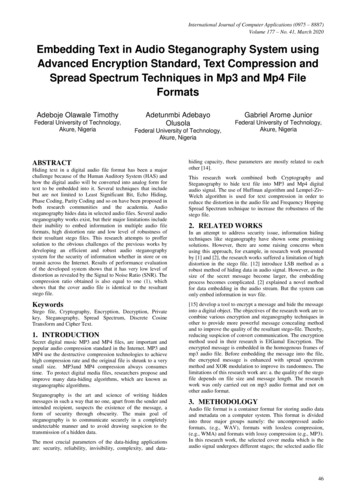
Transcription
International Journal of Computer Applications (0975 – 8887)Volume 177 – No. 41, March 2020Embedding Text in Audio Steganography System usingAdvanced Encryption Standard, Text Compression andSpread Spectrum Techniques in Mp3 and Mp4 FileFormatsAdeboje Olawale TimothyFederal University of Technology,Akure, NigeriaAdetunmbi AdebayoOlusolaFederal University of Technology,Akure, NigeriaABSTRACTHiding text in a digital audio file format has been a majorchallenge because of the Human Auditory System (HAS) andhow the digital audio will be converted into analog form fortext to be embedded into it. Several techniques that includebut are not limited to Least Significant Bit, Echo Hiding,Phase Coding, Parity Coding and so on have been proposed inboth research communities and the academia. Audiosteganography hides data in selected audio files. Several audiosteganography works exist, but their major limitations includetheir inability to embed information in multiple audio fileformats, high distortion rate and low level of robustness oftheir resultant stego files. This research attempts to proffersolution to the obvious challenges of the previous works bydeveloping an efficient and robust audio steganographysystem for the security of information whether in store or ontransit across the Internet. Results of performance evaluationof the developed system shows that it has very low level ofdistortion as revealed by the Signal to Noise Ratio (SNR). Thecompression ratio obtained is also equal to one (1), whichshows that the cover audio file is identical to the resultantstego file.KeywordsStego file, Cryptography, Encryption, Decryption, Privatekey, Steganography, Spread Spectrum, Discrete CosineTransform and Cipher Text.1. INTRODUCTIONSecret digital music MP3 and MP4 files, are important andpopular audio compression standard in the Internet. MP3 andMP4 use the destructive compression technologies to achievehigh compression rate and the original file is shrunk to a verysmall size. MP3and MP4 compression always consumestime. To protect digital media files, researchers propose andimprove many data-hiding algorithms, which are known assteganographic algorithms.Steganography is the art and science of writing hiddenmessages in such a way that no one, apart from the sender andintended recipient, suspects the existence of the message, aform of security through obscurity. The main goal ofsteganography is to communicate securely in a completelyundetectable manner and to avoid drawing suspicion to thetransmission of a hidden data.The most crucial parameters of the data-hiding applicationsare: security, reliability, invisibility, complexity, and data-Gabriel Arome JuniorFederal University of Technology,Akure, Nigeriahiding capacity, these parameters are mostly related to eachother [14].This research work combined both Cryptography andSteganography to hide text file into MP3 and Mp4 digitalaudio signal. The use of Huffman algorithm and Lempel-ZivWelch algorithm is used for text compression in order toreduce the distortion in the audio file and Frequency HoppingSpread Spectrum technique to increase the robustness of thestego file.2. RELATED WORKSIn an attempt to address security issue, information hidingtechniques like steganography have shown some promisingsolutions. However, there are some raising concerns whenusing this approach, for example, in research work presentedby [1] and [2], the research works suffered a limitation of highdistortion in the stego file. [12] introduce LSB method as arobust method of hiding data in audio signal. However, as thesize of the secret message become larger, the embeddingprocess becomes complicated. [2] explained a novel methodfor data embedding in the audio stream. But the system canonly embed information in wav file.[15] develop a tool to encrypt a message and hide the messageinto a digital object. The objectives of the research work are tocombine various encryption and steganography techniques inother to provide more powerful message concealing methodand to improve the quality of the resultant stego-file. Thereby,reducing suspicion of convert communication. The encryptionmethod used in their research is ElGamal Encryption. Theencrypted message is embedded in the homogenous frames ofmp3 audio file. Before embedding the message into the file,the encrypted message is enhanced with spread spectrummethod and XOR modulation to improve its randomness. Thelimitations of this research work are: a. the quality of the stegofile depends on file size and message length. The researchwork was only carried out on mp3 audio format and not onother audio format.3. METHODOLOGYAudio file format is a container format for storing audio dataand metadata on a computer system. This format is dividedinto three major groups namely: the uncompressed audioformats, (e.g., WAV), formats with lossless compression,(e.g., WMA) and formats with lossy compression (e.g., MP3).In this research work, the selected cover media which is theaudio signal undergoes different stages; the selected audio file46
International Journal of Computer Applications (0975 – 8887)Volume 177 – No. 41, March 2020irrespective of its format will be converted into .Wav (WaveFile Audio) format using a function in MATLAB.Many types of audio file are available, such as WindowsAudio Visual (WAV), Windows Media Audio (WMA), andMPEG (MP3). The type used in this study is WAV file formatof type Pulse Code Modulation (PCM), because it isuncompressed audio format, which gives more flexibility fordata hiding. A stego object (WAV file) with high samplingrate and sampling resolution may draw suspicion, because ofits large size, especially if its subjective quality is not high.Usually, it is easy to hide more secret data in the high qualityaudio data (for example, the use of least significant bitencoding to embed one bit in each sample, consist of 16 bits,sample has less effect on the stego object than adding one bitin a sample consist of 8 bits). In the developed system thewave files, with 8-bit samples resolution, are used as covermedia for hosting the secret data.There are some basic parameters to understand whendiscussing on digital audio files. This parameter includes:i.Sampling rate ( ) is the number of samples of audiocarried per seconds. It is measures in Hertz. In thisresearch, 44100Hz is used in wav audio format.ii.Frame size: The frame size is the amount of bits in eachframe.Frame Size iii.1Frequency Resolution ( ): It is the scaling factor,which ensures the cover medium is embedded below theaudibility threshold. It is measured in Hertz. HumanAuditory System (HAS) works dynamically in a widerange of frequencies between 20Hz-20000Hz. It iscalculated using equation 223.1 Embedding ModuleEmbedding module is a module at which the secret message(text file) is embedded into the selected cover medium (audioSignal). This is depicted in the figure 1.Figure 1: Architecture of the Embedding ModuleThe embedding module involves three processes whichinclude: plain text (secret message) encryption andcompression, audio signal decomposition as well as combinedsignal construction processes.The secret message which is in plain text is encrypted in orderto enhance the security of the secret message from theintruders by using a public key and private key to avoidunauthorized access of the text. This research work makes useof Advanced Encryption Standard (AES) over otherencryption algorithms because it uses higher length key sizessuch as 128, 192 and 256 bits for encryption, it uses 128-bitblock size and also has 10, 12 or 14 rounds of bits dependingon the key size used. Hence it makes AES algorithm morerobust against hacking. The general encryption procedure ismathematically represented in equation4whererepresents the Encryption function, M denotes thePlain text (Secret message), stands for Encryption Key, andis the cipher text.Figure 3: AES encryption algorithmThe encrypted text will be compressed using a two stagecompression techniques which are Huffman algorithm andLempel-Ziv Welch (LZW). Data compression is a method ofencoding rules that allows substantial reduction in the totalnumber of bits to store or transmit a file and this will help toreduce distortion in the stego file. The feature of both LZW(Lempel-Ziv-Welch) and Huffman algorithms are combinedto improve the compression ratio. The Huffman algorithms isrepresented as547
International Journal of Computer Applications (0975 – 8887)Volume 177 – No. 41, March 2020wheredenotes the length of the cipher text,the word character and is the number of bit.isLempel Ziv Welch is represented as 6whererepresents the compressed cipher text usingHuffman model,denotes the fixed codes anddenotesthe LZW compression.The main advantage of this combined algorithm is that thepercentage of data reduction increases more compared to theexisting text compression techniques.The audio format irrespective of its audio file format isconverted into .wav format. This is achieved using an audiowrite function in MATLAB.can be recognized by a receiver with the correct key. Thereare two types of spread spectrum techniques which are: DirectSequence Spread Spectrum (DSSS) and Frequency HoppingSpread Spectrum (FHSS). In Direct Sequence SpreadSpectrum, data to be transmitted is divided into small piecesand each piece is allocated to a frequency channel across thespectrum. In this research work, Frequency Hopping SpreadSpectrum is used. In Frequency-Hopping Spread Spectrum,the audio file's frequency spectrum is altered so that it hopsrapidly between frequencies. Spread spectrum combined thecompressed text file with the low frequencies of the audiosignal using:.8The embedded signal is added to the other frames of highfrequency using:9The analog signal generated is then converted into digitalsignal using the Inverse Discrete Cosine Transform (IDCT) asgiven below:10whereis the new audio signal (stego file).4. RESULT AND DISCUSSIONFigure 3: Audio format conversion to wav formatThe reason for this is that it will be easier to decompose thedigital audio signal into analog signal using the OneDimensional Discrete Cosine Transform (DCT).The DCT is one of the powerful compact transforms. Itrelocates most of the signal energy into the first transformcoefficients, lesser energy or information is relocated intoother (i.e., high frequency) coefficients. The frames thuscreated are queued based on the energies of the frames. DCTis applied on the voiced blocks that have power less than thepredefined second threshold value (T'). The block size wastaken small to avoid the high computational complexity ofDCT calculations which makes the system slow. Thereafter,frames will be selected using frequency frames with lowfrequency will be selected in order to ensure the secretmessage does not introduce audible distortion in the audiosignal. ,7forwherewhererepresents the original sequence of the audiosignal,denotes the Last frame in the audio file, is theNumber of frames in an audio file and denotes the framesize.Spread Spectrum technique was used to hide the encryptedand compressed secret message (Text file) into the digitalAudio signal. Spread spectrum is a method by which energygenerated in particular bandwidth is deliberately spread in thefrequency domain, resulting in a signal with a widerbandwidth. Spread spectrum () systems encodedata as a binary sequence which sounds like noise but whichThe system was implemented using MATLAB (R2017aversion) programming language on Windows 8.1 OperatingSystem platform with hardware configuration of 3GB RAM,1.6Hz Intel processor speed and 250GB of hard disk. In thisdeveloped system, MP3 and MP4 digital audio file formatwere used as the cover media and different ranges of secrettext were hidden into them for evaluation. The stego files(embedded audio file) were evaluated. The stego file (audiofile) retains its initial size after evaluating the proposedapproach and the amount of information that the developedsystem can hide is very high (500KB).The research work was evaluated using the followingperformance metrics: computational time, bit per character,compression ratio and signal to noise ratio.4.1 Compression RatioThis is the ratio of the cover medium before and after thesecret message is embedded into it to its ratio when the secretmessage is embedded into it.Compression Ratio 1From the result carried out in this research work, the systemhas a compression ratio of 1, which means the size of theaudio file before the secret message is embedded into it is stillthe same size after the secret message is embedded into it.4.2 Signal to Noise Ratio (SNR)Signal to noise ratio is a parameter used to know the amountby which the signal is corrupted by the noise. It is defined asthe ratio of the signal power to the noise power. Alternatively,it represents the ratio of desired signal (say a music file) to thebackground noise level. It is measured in decibel (db). SNRcan be calculated by equation below.SNR (db) 10where Stego file and2 Original Audio Signal48
International Journal of Computer Applications (0975 – 8887)Volume 177 – No. 41, March 20204.3.1 MP3 Audio Format4.3 Computational TimeMp3 file format, with size 4.58Nb and a length of 5 minuteswas used as an experiment to perform the performancemetrics. Table 1 shows the result of the evaluation.Table 1: Mp3 File Evaluation ResultThis is the time taken for the system to execute its function.From table 1, the values of the Signal to Noise ratio are morethan 50db when the size of the text file to be embedded rangesfrom 50kb to 200kb, and this indicates that there will be nodistortion in the audio. But from 250kb to 500kb, the valuesof the Signal to Noise Ratio began to decrease; making thevalues to be less than 50db and this implicates that there willbe distortion as the value decreases from 50db. This can berepresented graphically in figure 1.From table 2, the values of the Signal to Noise ratio goesabove 50db when the size of the text file to be embeddedranges from 50kb to 100kb, but the value of SNR for 150kb is49.3 which van be approximately to 50db can also beaccepted as good SNR vale. This indicates that there will beno distortion in the audio with a secrete message that’s up to150kb. But from 200kb to 500kb, the values of the SNRbegan to decrease; making the values to be less than 50db andthis implies that there will be distortion as the valuesdecreases from 50db. This is represented graphically in figure2.Figure 1: Graph of MP3 file format49
International Journal of Computer Applications (0975 – 8887)Volume 177 – No. 41, March 20204.3.2 MP4 Audio FormatMP4 file format, with size 4.70 Mb and a length of 5 minuteswas used as an experiment to perform the performancemetrics. Table 2 shows the result of the evaluation.Table 2: .MP4 File Evaluation Resultbut the system has the ability to embed a text size of 250kbwith respect to the digital audio length or size without anydistortion and has the ability to retain the same size afterembedding text into it.The work has been able to develop a robust stenographicsystem that would be very useful in securing and sharing largeamount of sensitive data or information without arousingsuspicion. This system is therefore recommended for securityagencies and other organization that consider informationsecurity as being of uttermost priority. This system is a usefulmeans for transmitting covert battlefield information via aninnocuous cover audio signal.6. REFERENCES[1] Wheeler, D., Johnson, D., Yuan, B., and Lutz, P. (2012).Audio Steganography Using High Frequency NoiseIntroduction.Figure 2: Graph of MP4 file format5. CONCLUSION ANDRECOMMENDATIONThere are a number of proven methods for applyingsteganography to hide information within audio data. In thisresearch work, an audio steganography system for MP3 andMP4 that uses using Discrete Cosine Transform (DCT) andspread spectrum techniques was developed. It was shownthrough implementation and subjective experimentation thatthe developed audio steganography system supports MP3 andMP4 digital audio format. The system developed has theability to embed a secret message of size that is up to 500kb[2] Ghanwat, D., and Rajan, R. S. (2013). Spread ain. Global Journal of Advanced EngineeringTechnologies, Vol2, Issue4-2013.[3] Bandyopadhyay, S. K., and Datta, B. (2011). HigherLSBlayerbasedaudiosteganographytechnique. IJECT, 2(4), 129-135.[4] Bertino, E. (2013, August). Data security–challenges andresearch opportunities. In Workshop on Secure DataManagement (pp. 9-13). Springer, Cham.[5] Bhowal, K., Pal, A. J., Tomar, G. S., and Sarkar, P. P.(2010, November). Audio steganography using GA.50
International Journal of Computer Applications (0975 – 8887)Volume 177 – No. 41, March 2020In Computational Intelligence and CommunicationNetworks (CICN), 2010 International Conference on (pp.449-453). IEEE.[6] Can, Y. S., Alagoz, F., & Burus, M. E. (2014). A NovelSpread Spectrum Digital Audio Watermarking. Journalof Advances in Computer Networks, 2(1)[7] Cheng, W. Q., Han, F., Tung, M. J., & Xu, K. (2007).Robust audio steganography using direct sequencespread spectrum technology. Technology, 1-6.[8] Dhore, V., & Arfat, P. M. (2015). Secure SpreadSpectrum Data Embedding and Extraction. InternationalJournal of Science and Research, 4(1), 743-747.[9] Divya, S. S., & Reddy, M. R. M. (2012). Hiding text inaudio using multiple LSB steganography and providesecurity using cryptography. International journal ofscientific & technology research, 1(6), 68-70.[10] Geetha, K., & Muthu, P. V. (2010). Implementation ofETAS (embedding text in audio signal) model to ensuresecrecy. International Journal on Computer Science andEngineering, 2(04), 1308-1313.IJCATM : www.ijcaonline.org[11] Olanrewaju, R. F., Othman Khalifa, H. A., and Suliman,R. (2013). Increasing the hiding capacity of low-bitencoding audio steganography using a novel embeddingtechnique.[12] Abdullah, A. M. (2017). Advanced Encryption Standard(AES)AlgorithmtoEncryptandDecryptData. Cryptography and Network Security.[13] Ali Khayam, S. (2003) .The Discrete Cosine Transform(DCT): Theory and Application. Information Theory andCoding, Seminar. The Discrete Cosine Transform:Theory and Application.[14] Atoum, Mohammed Salem, O. A. A. Rababah, and AlaaIsmat Al-Attili. "New technique for hiding data in audiofiles." Journal of Computer Science 11.4 (2011): 173177.[15] Kresnha, P. E., and Mukaromah, A. (2014). A RobustMethod of Encryption and Steganography using ElGamaland Spread Spectrum Technique Based on MP3 AudioFile. In Proceeding Conference on Application and ofElectromagnetic Technology, 3(9):11-15.51
encrypted message is embedded in the homogenous frames of Before embedding the message into the file, the encrypted message is enhanced with spread spectrum method and XOR modulation to improve its randomness. The limitations of this research work are: a. the quality of the stego file depends on file size and message length.
